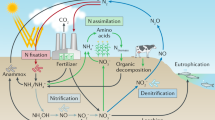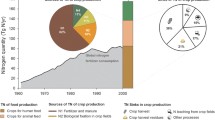Abstract
The world food supply has become dependent on synthetic fertilizer from ammonia, which comes from the Haber–Bosch process. This process consumes large amounts of fossil fuels and releases large amounts of greenhouse gases. The excessive use of synthetic fixed nitrogen fertilizers has led to severe environmental effects, but fixed nitrogen is essential to the sustainability of biofuels. Nitrogen fertilizers are also required for biotic carbon capture schemes like bioenergy with carbon capture and storage (BECCS), afforestation, and soil carbon sequestration. Ammonia has been proposed as a non-carbon emitting alternative fuel that has many advantages over hydrogen. Organic agriculture and nitrogen recovery from waste streams may only partially reduce the demand for synthetic fixed nitrogen. Social solutions like population stabilization may be the best solution for the food supply problem, but ammonia is an enabling technology for alternative fuels and carbon sequestration. Alternative processes for nitrogen fixation are very early in development. This paper offers the viewpoint that alternative means of nitrogen fixation and the wise use of fixed nitrogen need to be developed quickly.
Similar content being viewed by others
References
Ahlgren S, Baky A, Bernesson S, Nordberg Å, Olle Norén, Hansson P-A (2008) Ammonium nitrate fertiliser production based on biomass –Environmental effects from a life cycle perspective. Bioresour Technol 99:8034–8041
Anderson JS, Rittle J, Peters JC (2013) Catalytic conversion of nitrogen to ammonia by an iron model complex. Nature 501:84–88
Appl M (1999) Ammonia: principles and industrial practice. Wiley-VCH, Weinheim
Arashiba K, Miyake Y, Nishibayashi Y (2011) A molybdenum complex bearing PNP-type pincer ligands leads to the catalytic reduction of dinitrogen into ammonia. Nat Chem 3:120–125
Bauermeister U, Wild A, Meier T (2009) Stickstoffabtrennung mit dem ANAStrip®-Verfahren System GNS. In: Schutte A (ed) Gärrestaufbereitung für eine pflanzenbauliche Nutzung –Stand und F + E-Bedarf. Fachagentur Nachwachsende Rohstoffee (FNR), Gülzow, Deutschland, pp 78–95
Bodirsky BL, Popp A, Lotze-Campen H, Dietrich JP, Rolinski S, Weindl I, Schmitz C, Müller C, Bonsch M, Humpenöder F, Biewald A, Stevanovic M (2014) Reactive nitrogen requirements to feed the world in 2050 and potential to mitigate nitrogen pollution. Nat Commun 5:3858
Borowitzka MA, Moheimani NR (2013) Sustainable biofuels from algae. Mitig Adapt Strateg Glob Change 18:13–25
Broda H, Tuczek F (2014) Catalytic ammonia synthesis in homogeneous solution–biomimetic at last? Angew Chem Int Ed 53:632–634
Connor DJ (2013) Organically grown crops do not a cropping system make and nor can organic agriculture nearly feed the world. Field Crops Res 144:145–147
Crookes W (1899) President’s address. In: Report of the 68th meeting of the British association for the advancement of Science, John Murray, London, pp. 3–38. http://www.archive.org/details/reportofbritisha99brit. Accessed 1 Apr 2014
Čuček L, Klemeš JJ, Kravanja Z (2012) Carbon and nitrogen trade-offs in biomass energy production. Clean Technol Environ Policy 14:389–397
Davis ML (2011) Water and wastewater engineering: design principles and practice. McGraw-Hill, New York
Day D, Evans RJ, Lee JW, Reicosky D (2005) Economical CO2, SOx, and NOx capture from fossil-fuel utilization with combined renewable hydrogen production and large-scale carbon sequestration. Energy 30:2558–2579
de Vries W, Kros J, Kroeze C, Seitzinger SP (2013) Assessing planetary and regional nitrogen boundaries related to food security and adverse environmental impacts. Curr Opin Environ Sustain 5:392–402
Diouf J (2009) FAO’s director-general on how to feed the world in 2050. Popul Dev Rev 35:837–839
Dong R, Lu H, Yu Y, Zhang Z (2012) A feasible process for simultaneous removal of CO2, SO2 and NOx in the cement industry by NH3 scrubbing. Appl Energy 97:185–191
Erisman JW, van Grinsven H, Leip A, Mosier A, Bleeker A (2010) Nitrogen and biofuels: an overview of the current state of knowledge. Nutr Cycl Agroecosyst 86:211–223
Erisman JW, Galloway JN, Seitzinger S, Bleeker A, Dise NB, Petrescu AM, Leach AM, de Vries W (2013) Consequences of human modification of the global nitrogen cycle. Philos T Roy Soc B 368:20130116
FAO (2013) AQUASTAT database - Food and Agriculture Organization of the United Nations. www.fao.org/nr/water/aquastat/data/query/index.html?lang=en Accessed 3 Apr 2014
FAO (2014) FAOSTAT database - Food and Agriculture Organization of the United Nations. http://faostat3.fao.org/faostat-gateway/go/to/download/R/RF/E Accessed 3 Apr 2014
Galvez ME, Halmann M, Steinfeld A (2007) Ammonia production via a two-step Al2O3/AlN thermochemical cycle. 1. Thermodynamic, environmental, and economic analyses. Ind Eng Chem Res 46:2042–2046
Giddey S, Badwal SPS, Kulkarni A (2013) Review of electrochemical ammonia production technologies and materials. Int J Hydrog Energy 38:14576–14594
Gilbert P, Alexander S, Thornley P, Brammer J (2014) Assessing economically viable carbon reductions for the production of ammonia from biomass gasification. J Clean Prod 64:581–589
Greenwell HC, Laurens LML, Shields RJ, Lovitt RW, Flynn KJ (2010) Placing microalgae on the biofuels priority list: a review of the technological challenges. J R Soc Interface 7:703–726
Han FX, King RL, Lindner JS, Yu TY, Durbha SS, Younan NH, Monts DL, Su Y, Luthe JC, Plodinec MJ (2011) Nutrient fertilizer requirements for sustainable biomass supply to meet U.S. bioenergy goal. Biomass Bioenergy 35:253–262
Hardin G (1968) The tragedy of the commons. Science 16:1243–1248
Hess RJ, Foust TD, Hoskinson R, Thompson D (2003) Roadmap for agricultural biomass feedstock supply in the United States. 2003 Report DOE/NE-ID-11129 Rev. 1
Holma A, Koponen K, Antikainen R, Lardon L, Leskinen P, Roux P (2013) Current limits of life cycle assessment framework in evaluating environmental sustainability - case of two evolving biofuel technologies. J Clean Prod 54:215–228
IFA (2009a) Feeding the earth: energy efficiency and CO2 emissions in ammonia production. International Fertilizer Industry Association, Paris
IFA (2009b) Fertilizers, climate change and enhancing agricultural productivity sustainably. International Fertilizer Industry Association, Paris
IFA (2014) Fertilizer Outlook 2014-2018. International Fertilizer Industry Association, Paris
IFOAM (2005) Principles of organic agriculture preamble. International Federation of Organic Agriculture Movements, Bonn, Germany. www.ifoam.org/en/organic-landmarks/principles-organic-agriculture Accessed 3 Apr 2014
Jia H-P, Quadrelli EA (2014) Mechanistic aspects of dinitrogen cleavage and hydrogenation to produce ammonia in catalysis and organometallic chemistry: relevance of metal hydride bonds and dihydrogen. Chem Soc Rev 43:547–564
Lan R, Irvine JTS, Tao S (2013) Synthesis of ammonia directly from air and water at ambient temperature and pressure. Sci Rep. doi:10.1038/srep01145
Liu YH, Kumar S, Kwa J-H, Ra CS (2013) Magnesium ammonium phosphate formation, recovery and its application as valuable resources: a review. J Chem Technol Biotechnol 88:181–189
Macdonald CA, Anderson IC, Bardgett RD, Singh BK (2011) Role of nitrogen in carbon mitigation in forest ecosystems. Curr Opin Environ Sustain 3:303–310
Michalsky R, Parman BJ, Amanor-Boadu V, Pfromm PH (2012) Solar thermochemical production of ammonia from water, air and sunlight: thermodynamic and economic analyses. Energy 42:251–260
Nowak B, Nesme T, David C, Pellerin S (2013) To what extent does organic farming rely on nutrient inflows from conventional farming? Environ Res Lett 8 doi:10.1088/1748-9326/8/4/044045
Obersteiner M, Azar C, Kauppi P, Möllersten K, Moreira J, Nilsson S, Read P, Riahi K, Schlamadinger B, Yamagata Y, Yan J, Van Ypersele J-P (2001) Managing climate risk [3]. Science 294:786–787
Oldroyd GED, Dixon R (2014) Biotechnological solutions to the nitrogen problem. Curr Opin Biotechnol 26:19–24
Olson N (2013) NH3 fuel — gaining momentum. Tenth Annual NH3 Fuel Conference, September 23, 2013. nh3fuelassociation.org/2013/09/16/nh3-fuel-gaining-momentum Accessed 3 Apr 2014
Rafiqul I, Weber C, Lehmann B, Voss A (2005) Energy efficiency improvements in ammonia production - perspectives and uncertainties. Energy 30:2487–2504
Razon LF (2012) Life cycle energy and greenhouse gas profile of a process for the production of ammonium sulfate from nitrogen-fixing photosynthetic cyanobacteria. Bioresour Technol 107:339–346
Razon LF (2013) Life cycle analysis of an alternative to the Haber-Bosch process: non-renewable energy usage and global warming potential of liquid ammonia from cyanobacteria. Environ Prog Sustain Energy. doi:10.1002/ep11817
Reiter AJ, Kong SC (2011) Combustion and emissions characteristics of compression-ignition engine using dual ammonia-diesel fuel. Fuel 90:87–97
Reşitoğlu IA, Altinişik K, Keskin A (2014) The pollutant emissions from diesel-engine vehicles and exhaust aftertreatment systems. Clean Technol Environ Policy. doi:10.1007/s10098-014-0793-9
Rockström J, Steffen W, Noone K, Persson A, Chapin FS III, Lambin E, Lenton TM, Scheffer M, Folke C, Schellnhuber HJ, Nykvist B, de Wit CA, Hughes T, van der Leeuw S, Rodhe H, Sörlin S, Snyder PK, Costanza R, Svedin U, Falkenmark M, Karlberg L, Corell RW, Fabry VJ, Hansen J, Walker B, Liverman D, Richardson K, Crutzen P, Foley J (2009) Planetary boundaries: exploring the safe operating space for humanity. Ecol Soc 14:32
Ryu K, Zacharakis-Jutz GE, Kong SC (2014) Performance enhancement of ammonia-fueled engine by using dissociation catalyst for hydrogen generation. Int J Hydrog Energy 39:2390–2398
Seufert V, Ramankutty N, Foley JA (2012) Comparing the yields of organic and conventional agriculture. Nature 485:229–234
Sikdar SK (2013) Resurgence of fossil fuels? Clean Technol Environ Policy 15:203–204
Skinner C, Gattinger A, Muller A, Mäder P, Fließbach A, Stolze M, Ruser R, Niggli U (2014) Greenhouse gas fluxes from agricultural soils under organic and non-organic management—A global meta-analysis. Sci Total Environ 468–469:553–563
Smil V (2001) Enriching the earth: Fritz Haber, Carl Bosch, and the transformation of world food production. MIT Press, Cambridge
Smith P (2013) Delivering food security without increasing pressure on land. Glob Food Secur 2:18–23
Smith LJ, Torn MS (2013) Ecological limits to terrestrial biological carbon dioxide removal. Climat Chang 118:89–103
Stockmann U, Adams MA, Crawford JW, Field DJ, Henakaarchchi N, Jenkins M, Minasnya B, McBratney AB, de de Remy Courcelles V, Singh K, Wheeler I, Abbott L, Angers DA, Baldock J, Bird M, Brookes PC, Chenu C, Jastrow JD, Lal R, Lehmann J, O’Donnell AG, Parton WJ, Whitehead D, Zimmermann M (2013) The knowns, known unknowns and unknowns of sequestration of soil organic carbon. Agric Ecosyst Environ 164:80–99
Tilman D, Balzer C, Hill J, Befort B (2011) Global food demand and the sustainable intensification of agriculture. Proc Natl Acad Sci USA 108:20260–20264
Tuomisto HL, Hodge ID, Riordan P, Macdonald DW (2012) Does organic farming reduce environmental impacts? A meta-analysis of European research. J Environ Manag 112:309–320
United Nations, Department of Economic and Social Affairs, Population Division (2013) World Population Prospects: The 2012 Revision, Key Findings and Advance Tables. Working Paper No. ESA/P/WP.227
Wolfram|Alpha (2014) Wolfram Alpha LLC. www.wolframalpha.com/input/?i=world+population+growth&lk=4 Accessed 30 Apr 2014
Xu GC, Liu RQ, Wang J (2009) Electrochemical synthesis of ammonia using a cell with a Nafion membrane and SmFe0.7Cu0.3−xNixO3 (x = 0–0.3) cathode at atmospheric pressure and lower temperature. Sci China Ser B-Chem 52:1171–1175
Yandulov DV, Schrock RR (2003) Catalytic reduction of dinitrogen to ammonia at a single molybdenum center. Science 301:76–78
Zamfirescu C, Dincer I (2009) Ammonia as a green fuel and hydrogen source for vehicular applications. Fuel Process Technol 90:729–737
Acknowledgments
The author would like to thank the Tan Yan Kee Foundation and the Gokongwei College of Engineering of De La Salle University for the grant of a professorial chair. Prof Raymond Tan is (once again) thanked for reviewing the manuscript and some very helpful advice.
Author information
Authors and Affiliations
Corresponding author
Rights and permissions
About this article
Cite this article
Razon, L.F. Is nitrogen fixation (once again) “vital to the progress of civilized humanity”?. Clean Techn Environ Policy 17, 301–307 (2015). https://doi.org/10.1007/s10098-014-0835-3
Received:
Accepted:
Published:
Issue Date:
DOI: https://doi.org/10.1007/s10098-014-0835-3




